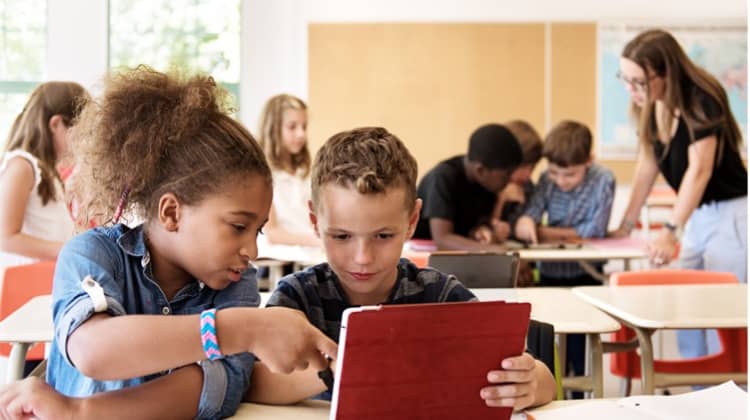In many ways, schools are microcosms of our cities. Although often segregated by class, municipal public schools see nearly every type of student, representing nearly every type of family. While the possibilities for ed-tech— or educational technology— are vast and varied in higher education, this essay will primarily focus on primary education, those bellwethers of mass-scale governmental and societal change.
iiStock: lisegagne, ID: 587201104
Where Do Education and Smart Cities Intersect?
Many new technologies, strategies, and ways of contemporary thought are first or simultaneously tested out in our schools alongside the greater community. Think of the internet itself. Oftentimes, especially for students on the lower end of the income bracket, primary schools were the first places young people began “browsing the web”, using email, sending instant messages, and conducting online research— the internet itself.
Like many of the technologies discussed below, primary schools were not necessarily where these technologies and ideas were first implemented, but were where masses of people first interacted with them. In the same manner, through these new educational innovations we can extrapolate their effects on smart cities themselves, and the ways in which we might work, live, and govern in the future.
Defining Ed-Tech
Of course, the pandemic changed education and work forever. Nearly half of workers in the Global North worked remotely from home during the height of the pandemic. About that same number will keep working remotely, and 80 percent of workers say they are more productive working from home.
These same changes affected students and schools themselves. While once relegated to specialty students, today nearly every student in the western world has now experienced “online education”, even if in a limited capacity, with mixed results.
While the jury is still out on total e-learning during the pandemic, IE school via video from home, some sobering statistics have emerged. A study, with insight from Population Europe, although not yet peer reviewed, is worth quoting at length:
"Our study found robust evidence that students are still learning less in lockdown than in a normal year. The lost progress amounts to about a fifth of a school year, almost exactly the same period that schools remained closed (assuming a regular school year is ten months). In other words, the data suggest that nearly every hour out of school was an hour of lost student learning. These losses are not distributed equally. Students from low-educated homes were disproportionately affected, with a 50% larger drop in performance than their more advantaged peers. We could also confirm that most of the drop in performance reflects the actual knowledge learned as opposed to testing performance as such. Performance on tests not related to the curriculum also declined, but to a much lesser extent than in core subjects such as Maths, Reading and Spelling."
“Online education” and “remote learning” are simply the most widely-recognized recent examples of Ed-Tech. According to Wikipedia, a tangential example of ed-tech itself, “Educational technology is the combined use of computer hardware, software, and educational theory and practice to facilitate learning. When referred to with its abbreviation, edtech, it is often referring to the industry of companies that create educational technology.”
That second sentence is important, as the drivers of ed-tech are generally private businesses working in public spaces. This industry can be a boon for cities, creating employment opportunities and adding to the economy (The worldwide e-learning market is projected to be worth $325 Billion in 2025), but whose purposes might be at odds with the nature of public primary schools.
Much study is still needed to see which facets of ed-tech are viable in the future, but let’s take a look at some examples of where educational technology is headed in schools, and what they may look like, and how they might be used, for and in the wider community itself:
- Online and Remote Learning
As mentioned before, online and remote learning has touched nearly every student in the western world due to the pandemic, with mixed results. Some of these deeper results, such as the concerns of social isolation, won’t be known for years.
What we do know is, online learning is now solidly entrenched in our culture. According to researchers at Springer Link, “[I]n the first half of 2020, over 90% of school children worldwide (1.5 billion) were hit by fully or partially closed schools. One year into the pandemic, school closures still affect almost 50% of the world’s students (UNESCO 2021a).
It’s yet too early to tell what the numbers are for the 2022/23 school year, but stadia notes online education of all types is permeating the culture at large. “Approximately 18 percent of [total] individuals in the European Union did an online course of any subject in 2021. During this year, the Netherlands had the highest share of people doing an online course, at 41 percent.”
It’s likely that this upward trend will continue, and we’ll see more and more municipal education being done online, from remedial traffic school and first aid courses, to continuing education and professional certification.
- Unprecedented Access
Because of the widespread nature of online learning, it brings unprecedented access to some of the world's best and best known teachers, celebrities, and educational institutions. Right now, anyone can take some of Harvard University's most popular classes for free, and with services like Masterclass aspiring students can learn acting from the likes of Samuel L. Jackson or business from Richard Branson.
This is one of the areas we are seeing business take the lead, which will filter into schools and municipalities themselves. It’s a short leap from learning about literature by reading bestselling writers, to bringing courses by those bestselling writers into primary schools. Just as higher education has made teaching appointments prestige positions for field leaders, technology will make this economically viable, in smaller scale, in primary schools where celebrity can be leveraged for attention from hard-to-motivate students.
- Augmented Reality
Augmented reality is like virtual reality in that it uses technology to create immersive experiences and the digital world to change perceptions of what is real and possible. Unlike VR, augmented reality or AR, adds digital assets to the real world and is, by design, not fully immersive. An excellent example of AR is the Tresor 31 art exhibition at the former Kraftwerk power plant in Berlin, where attendees are given an audio headset that changes inputs based on signals received as participants walk through the exhibit.
A number of augmented reality programs have already been implemented in schools, including tools to explore museums and practice handwriting. The technology will likely be more widely utilized as prices are reduced.
AR has massive implications for average citizens of cities as well. AR has the potential to be used for citizens to get a feel for what a new development might look like in their neighborhood, how public utilities work, and as aids to direction finding within cities and traffic, to name a few.
- Artificial Intelligence
In this fascinating article by futurist Bernard Marr concerning artificial intelligence use in schools, “It is expected that artificial intelligence in U.S. Education will grow by 47.5% from 2017-2021 according to the Artificial Intelligence Market in the US Education Sector report.”
According to Marr, AI is also being used to develop testing systems and educational assessment tools, but perhaps its greatest possibility is to be utilized in individualizing learning programs for students. This can be a great boon to struggling teachers and students.
The use of AI in smart cities is almost unlimited but early areas of focus will likely be on transportation, safety, and power grids.
- Learning Management Systems
Learning management systems are basically giant planners for an entire education and can contain files, videos, homework assignments, nearly every digital resource a student might need in the classroom. Students use programs like Course, Moodle, and Blackboard to track their grades, to submit assignments, access digital materials like PDF’s and videos, and much more.
Learning management systems are great examples of where the government, especially, can learn from schools. Imagine if all of your visa or licensing applications, taxes, fines and fees, energy usage, etc. could be tracked in one place. It could drastically increase efficiency and ease for citizens in dealing with governmental agencies as well as serve as a digital identification.
Drawbacks and Responses
The continued use of ed-tech in schools and in smart cities doesn’t come without drawbacks and concerns. Below we’ll detail just a few issues in brief.
- In-person learning
As the pandemic has shown us, sometimes there is no real substitute for in-person learning and meetings. While platforms like Zoom can help time-strapped citizens from around the world attend meetings they normally wouldn’t, questions remain about their overall effectiveness. One of the most important parts of smart cities— or any city— remains neighborliness, and there is little substitute for face-to-face conversations.
- Digital Divide
The digital divide refers to who has access to technology, the means to purchase it, and the education to use it. Particularly for those on the bottom of the economic scale, the elderly, and others who didn’t grow up with access to it, technology can be a hindrance to participation in civic life rather than a boon. Great care will need to be taken as more governance and civil life comes online, so that we are not leaving segments of the population behind and shut out of civic life.
- Concerns About Privacy
With technology comes data, massive amounts of data. This data is extremely valuable to businesses, but for many citizens, keeping their online footprints to themselves is of the utmost importance. There is also the potential for the misuse of this data by third parties, bad actors, and the government itself. Having robust data protection will be essential for buy-in for future users.
CONCLUSION ABOUT SMART EDUCATION:
Technology will undoubtedly play a massive role in the future of cities, and it’s a question of when rather if these ideas are implemented. However, ease of transition and uptake by citizens will depend entirely on their implementation, ease of use, and assuaging some of the drawbacks.


